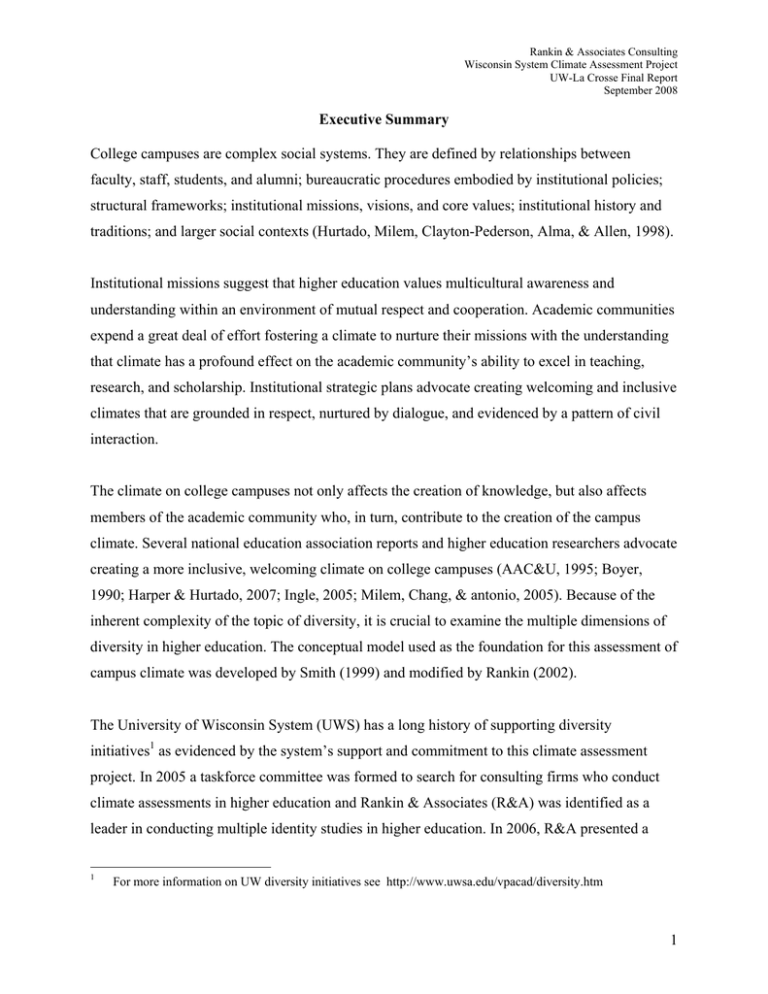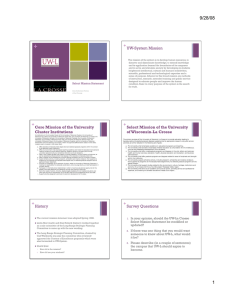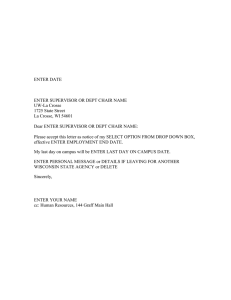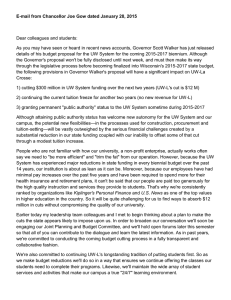
Rankin & Associates Consulting
Wisconsin System Climate Assessment Project
UW-La Crosse Final Report
September 2008
Executive Summary
College campuses are complex social systems. They are defined by relationships between
faculty, staff, students, and alumni; bureaucratic procedures embodied by institutional policies;
structural frameworks; institutional missions, visions, and core values; institutional history and
traditions; and larger social contexts (Hurtado, Milem, Clayton-Pederson, Alma, & Allen, 1998).
Institutional missions suggest that higher education values multicultural awareness and
understanding within an environment of mutual respect and cooperation. Academic communities
expend a great deal of effort fostering a climate to nurture their missions with the understanding
that climate has a profound effect on the academic community’s ability to excel in teaching,
research, and scholarship. Institutional strategic plans advocate creating welcoming and inclusive
climates that are grounded in respect, nurtured by dialogue, and evidenced by a pattern of civil
interaction.
The climate on college campuses not only affects the creation of knowledge, but also affects
members of the academic community who, in turn, contribute to the creation of the campus
climate. Several national education association reports and higher education researchers advocate
creating a more inclusive, welcoming climate on college campuses (AAC&U, 1995; Boyer,
1990; Harper & Hurtado, 2007; Ingle, 2005; Milem, Chang, & antonio, 2005). Because of the
inherent complexity of the topic of diversity, it is crucial to examine the multiple dimensions of
diversity in higher education. The conceptual model used as the foundation for this assessment of
campus climate was developed by Smith (1999) and modified by Rankin (2002).
The University of Wisconsin System (UWS) has a long history of supporting diversity
initiatives1 as evidenced by the system’s support and commitment to this climate assessment
project. In 2005 a taskforce committee was formed to search for consulting firms who conduct
climate assessments in higher education and Rankin & Associates (R&A) was identified as a
leader in conducting multiple identity studies in higher education. In 2006, R&A presented a
1
For more information on UW diversity initiatives see http://www.uwsa.edu/vpacad/diversity.htm
1
Rankin & Associates Consulting
Wisconsin System Climate Assessment Project
UW-La Crosse Final Report
September 2008
proposal to the UWS Provosts and various constituent groups which resulted in the formation of
the Climate Study Working Group (CSWG) by UWS administrators and subsequent contracting
with R&A to facilitate a system-wide climate assessment.
Fact-finding groups were held in September 2007 to discuss with University of Wisconsin
System students, staff, and faculty their perceptions of the system climate. Informed by these
fact-finding groups and by previous R&A work, the CSWG developed the final survey
instrument template that was administered to the five participating UW campuses in spring 2008.
UW-La Crosse was one of the five UWS institutions that participated in the initial climate
project in 2007-2008. A Diversity Leadership Committee (DLC) was created at UW-La Crosse
to assist in coordinating the survey effort on campus. The DLC reviewed the survey template and
revised the instrument to better match the context at UW-La Crosse. The final survey contained
91 questions including several open-ended questions for respondents to provide commentary.
This report provides an overview of the findings of the internal assessment, including the results
of the campus-wide survey and a thematic analysis of comments provided by survey
respondents.
All members of the campus community (e.g., students, faculty, academic staff, and classified
staff) were invited to participate in the survey. The survey was designed for respondents to
provide information about their personal experiences with regard to climate issues, their
perceptions of the campus climate, employees’ work-life issues, and respondents’ perceptions of
institutional actions, including administrative policies and academic initiatives regarding climate
issues and concerns on campus. A summary of the findings, presented in bullet form below,
suggests that while the UW-La Crosse has several challenges with regard to diversity issues,
these challenges are found in many other institutions of higher education across the country.
2
Rankin & Associates Consulting
Wisconsin System Climate Assessment Project
UW-La Crosse Final Report
September 2008
Sample Demographics
2,576 surveys were returned representing the following:
23 percent response rate
1,877 undergraduate students, 152 graduate students, 200 faculty, 172 academic
staff, and 132 classified staff
228 people of color;2 2,297 White respondents
42 people who identified as having a physical disability
24 people who identified as having a learning disability
71 people who identified as having a psychological condition
115 people who identified as lesbian, gay, bisexual, or queer; and 30 who were
questioning their sexuality
1,790 women; 770 men; 4 transgender persons3
754 people who identified their spiritual affiliation as other than Christian
(including those with no affiliation)
Quantitative Findings
Personal Experiences with Campus Climate4
•
A percentage of respondents reported that they personally experienced offensive,
hostile, or intimidating conduct that interfered unreasonably with their ability to
work or learn on campus on campus (hereafter referred to as harassment).5 Gender
was most often cited as the reason given for the perceived harassment. People of
color and sexual minorities6 perceived such harassment more often than White
people, and many of them felt it was due to their race or sexual orientation.
Perceived harassment largely went unreported.
o 17 percent of respondents believed that they had personally experienced
offensive, hostile, or intimidating conduct that interfered unreasonably with their
ability to work or learn on campus.
2
3
4
5
6
While recognizing the vastly different experiences of people of various racial identities (e.g., Chicano(a) versus AfricanAmerican or Latino(a) versus Asian-American), and those experiences within these identity categories (e.g., Hmong versus
Chinese), Rankin and Associates found it necessary to collapse some of these categories to conduct the analyses due to the
small numbers of respondents in the individual categories.
“Transgender” refers to identity that does not conform unambiguously to conventional notions of male or female gender, but
combines or moves between these (Oxford English Dictionary, 2003). OED Online. March 2004. Oxford UW Press. Feb.
17, 2006 <http://dictionary.oed.com/cgi/entry/ 00319380>.
Listings in the narrative are those responses with the greatest percentages. For a complete listing of the results, the reader is
directed to the tables in the narrative and Appendix B.
Under the United States Code Title 18 Subsection 1514(c)1, harassment is defined as "a course of conduct directed at a
specific person that causes substantial emotional distress in such a person and serves no legitimate purpose"
(http://www.eeoc.gov/laws/vii.html). In higher education institutions, legal issues discussions define harassment as any
conduct that has unreasonably interfered with one’s ability to work or learn on campus. The questions used in this survey to
uncover participants’ personal and observed experiences with harassment were designed using these definitions.
Sexual minorities are defined, for the purposes of this report, as people who identify as lesbian, gay, or bisexual.
3
Rankin & Associates Consulting
Wisconsin System Climate Assessment Project
UW-La Crosse Final Report
September 2008
o The perceived conduct was most often based on the respondents’ gender (36%),
UW-L status (22%), age (21%), political views (17%), and religious/spiritual
status (17%).
o Compared with 15 percent of White people, 34 percent of people of color
believed they had personally experienced such conduct.
o Of respondents of color who reported experiencing this conduct, 56 percent stated
it was because of their race.
o Compared with 18 percent of men, 17 percent of women believed they had
personally experienced such conduct.
o Of the women who experienced this conduct, 45 percent stated it was because of
their gender.
o Compared with 16 percent of heterosexual respondents, 38 percent of sexual
minority respondents believed they had personally experienced such conduct.
o Of sexual minority respondents who experienced this conduct, 61 percent stated it
was because of their sexual orientation.
o 19 percent of participants made complaints to UW-L officials, while 13 percent
did not know who to go to, and 13 percent did not report the incident for fear of
retaliation.
•
A small percentage of respondents believed that they had been sexually harassed or
sexually assaulted.
o 12 percent believed that they had been touched in a sexual manner that made them
feel uncomfortable or fearful while at UW-La Crosse.
o 96 respondents believed that they had been sexually assaulted during their time at
UW-La Crosse.
o Women, lesbians, and people who identified as queer were more likely than other
groups to believe that they had been sexually assaulted.
o Most of the respondents who believed that they had been sexually assaulted were
students (86 people), female (91 people), heterosexual (84 people), and White (86
people).
o The alleged perpetrator of the perceived sexual assault was most often a student,
an acquaintance, a friend, or a stranger.
Perceptions of Campus Climate
•
Most respondents indicated that they were “comfortable” or “very comfortable”
with the overall climate at UW-La Crosse (85%), in their departments or work units
(84%), and in their classes (85%). The figures in the narrative demonstrate some
disparities based on race.
o Compared with 86 percent of White people, 74 percent of people of color were
“comfortable” or “very comfortable” with the overall climate at UW-L.
o Compared with 86 percent of White people, 77 percent of people of color were
“comfortable” or “very comfortable” with the climate in their departments or
work units.
4
Rankin & Associates Consulting
Wisconsin System Climate Assessment Project
UW-La Crosse Final Report
September 2008
o Compared with 97 percent of White people, 69 percent of people of color were
“comfortable” or “very comfortable” with the climate in their classes.
•
Slightly more than one-third of all respondents indicated that they were aware of or
believed they had observed harassment on campus. The perceived harassment was
most often based on sexual orientation, ethnicity, gender, and race. People of color
and sexual minorities were more aware of perceived harassment.
o 34 percent of the participants believed that they had observed or personally been
made aware of conduct on campus that created an offensive, hostile, or
intimidating working or learning environment.
o Most of the observed harassment was based on sexual orientation (48%), ethnicity
(37%), gender (37%), or race (36%).
o Compared with 32 percent of White respondents, 45 percent of respondents of
color believed they had observed or personally been made aware of such conduct.
o Compared with 32 percent of heterosexuals, 64 percent of sexual minorities
believed they had observed or personally been made aware of such conduct.
o Compared with 32 percent of students and 33 percent of classified staff, 49
percent of faculty and 42 percent of academic staff believed they had observed
such conduct.
o These incidences were reported to an employer or official only 10 percent of the
time.
•
Some employee respondents believed that they had observed discriminatory
employment practices, and indicated that these practices were most often based on
gender.
o 31 percent of employee respondents believed that they had observed discriminatory
hiring.
o 13 percent believed that they had observed discriminatory employment-related
disciplinary actions at UW-L (up to and including dismissal).
o 29 percent believed that they had observed discriminatory promotion practices.
•
With regard to campus accessibility for people with mobility and visual impairment,
campus walkways/pathways (66%), and University websites (60%), were considered the
most accessible (rated “very accessible” or “accessible”) areas of campus.
o 25 percent ranked the residence halls as “very inaccessible.”
Satisfaction with UW-La Crosse
•
79 percent of UW-L employees were “highly satisfied” or “satisfied” with their jobs at
UW-L. 62 percent were “highly satisfied” or “satisfied” with the way their careers have
progressed at UW-La Crosse.
o Faculty were slightly less satisfied with their jobs than were other employees.
o Men were most satisfied with the way their careers have progressed at UW-La
Crosse.
5
Rankin & Associates Consulting
Wisconsin System Climate Assessment Project
UW-La Crosse Final Report
September 2008
•
89 percent of percent of students were “highly satisfied” or “satisfied” with their
education at UW-L, while 77 percent were “highly satisfied” or “satisfied” with the way
their academic careers have progressed at UW-La Crosse.
o A slightly lower percentage of students of color were satisfied with their educations
and with the way their academic careers have progressed at UW-La Crosse than were
other students.
o Higher percentages of women students, White students, and heterosexual students
were satisfied with the way their academic careers have progressed than were men
students, students of color, and sexual minority students.
•
39 percent of all respondents have seriously considered leaving UW-La Crosse.
o Among employees, 65 percent of men and 62 percent of women thought of leaving
UW-L.
o 61 percent of employees of color, in comparison with 63 percent of White employees,
have seriously considered leaving UW-L. Additionally, 68 percent of sexual minority
employees, compared to 63 percent of heterosexual respondents, have seriously
thought of leaving the institution.
o Among students, 33 percent of women and 34 percent of men considered leaving the
University.
o 47 percent of students of color and 32 percent of White students thought of leaving
UW-L, as did 36 percent of LGB students and 33 percent of heterosexual students.
Institutional Actions
•
•
•
•
•
•
•
•
•
More than half of the respondents “strongly agreed” or “agreed” that the Chancellor,
Deans and Directors, and Campus Climate Coordinator provided visible leadership that
fosters inclusion of diverse members of the campus community.
90 percent of all respondents believed the Chancellor’s Office has visible leadership that
fosters inclusion of diverse members of the campus community.
41 percent of all respondents believed the Provost’s Office has visible leadership that
fosters inclusion of diverse members of the campus community.
58 percent of all respondents believed that diversity initiatives are relevant to their work.
67 percent felt welcome at campus diversity events.
53 percent of employee respondents thought providing tenure clock options with more
flexibility for promotion/tenure for faculty/staff with families would positively affect the
climate.
70 percent thought it would be a good idea to train mentors and leaders within
departments to model positive climate behavior.
63 percent thought offering diversity training/programs as community outreach would
positively affect the climate.
Less than half of all employees thought providing recognition and rewards for including
diversity in course objectives throughout the curriculum and rewarding research efforts
that evaluate outcomes of diversity training would positively affect the climate.
6
Rankin & Associates Consulting
Wisconsin System Climate Assessment Project
UW-La Crosse Final Report
September 2008
•
•
74 percent of employees felt providing on-campus child care services would positively
affect the climate.
More than three-quarters of all employees thought the following initiatives would also
positively affect the climate on campus: improving, and promoting access to quality
services for those individuals who experience sexual abuse (79%), providing mentors for
minority faculty/students/staff new to campus (75%), and providing a clear protocol for
responding to hate/hostile incidents at the campus level (83%) and departmental level
(83%).
Qualitative Findings
Out of the 2,576 surveys received at UW-La Crosse, 1,840 respondents contributed remarks to
the four open-ended questions. Respondents included undergraduate and graduate students, as
well as faculty, academic staff, and classified staff. The four open-ended questions asked
whether their campus experiences differed from experiences in the surrounding community, for
general elaboration of personal experiences and thoughts,7 and to name three things the
respondent would like to see changed on campus and three things they would like to see remain
the same. The qualitative comments give “voice” to the quantitative findings and also parallel
those findings.
Of the 756 respondents who commented on whether their experiences on campus differed from
their experiences in the surrounding community, most of the remarks indicated that the campus
climate was more diverse, more accepting of difference, and felt to students more comfortable
and safe. Some individuals said there was little difference between the community and the
campus, and some commented that the surrounding community was more accepting of people
regardless of their educational background and more respectful of those in the military than were
people on campus. In addition, people of color and sexual minority respondents felt more
comfortable on campus than off campus.
Eight hundred forty-seven respondents provided examples of things they would like to see
changed at UW-L and things they would like to see the same. Several respondents wanted to see
7
The complete survey is available in Appendix C.
7
Rankin & Associates Consulting
Wisconsin System Climate Assessment Project
UW-La Crosse Final Report
September 2008
more diversity and more diversity-related events on campus, while others were content with the
number and frequency of diversity-related events and exchanges. Those respondents that wanted
to see more diversity suggested the University create additional programs, integrated course
offerings, and readily accessible information about ethnic issues, sexual orientation, and sexual
assault. Respondents wanted ethnic issues to focus not just on Black-White issues, but issues
faced by Asians, Native Americans, and Latinos. They advised the University to recruit more
inner-city minority students, and hire more RAs of color and women leaders. Several
respondents said UW-L ought to focus some attention on making buildings (especially residence
halls) and grounds more accessible for people with disabilities. A number of students wanted to
see the cost reduced for dining at Whitney, tuition reduced, and increased financial aid. Staff
wanted their salaries to be comparable to private sector, and classified staff wanted more respect,
more formal opportunities for professional growth, responsibility, and pay raises. Several
respondents wanted to end the disparate system that exists among faculty and staff.
Respondents liked the size of UW-L campus community, felt the community was very friendly,
and wanted it to remain the same. In addition, several respondents commented that they wanted
the Chancellor and the relationships Dr. Gow has with campus community members to stay the
same. Respondents believed in the excellence of the UW-L education and hope the University
would continue to attract quality teachers and scholars. Some respondents wanted to keep the
EFN classes, and suggested the structure of the classes change. Several individuals liked the
Campus Climate Office and the Chancellor’s Open Forums.
Two hundred seventy-eight (278) respondents offered suggestions for how to improve the
climate at UW-La Crosse. A number of respondents praised Chancellor Gow’s efforts in regard
to diversity and asked for continued attention to and leadership on the issues. Some respondents
wanted to see more people from underrepresented populations in the faculty and administrative
ranks. Others despised minority quotas and wanted to make sure that jobs always go to the most
qualified applicants. Likewise, a few respondents asked that the University divert dollars away
from diversity initiatives and spend money only on educating students. Several respondents
described bullying that goes on in their departments and asked for ways to monitor/reprimand
8
Rankin & Associates Consulting
Wisconsin System Climate Assessment Project
UW-La Crosse Final Report
September 2008
co-workers and supervisors who are known bullies. Many people asked that UW-L continue to
communicate with all constituents, employees, and students about all aspects of University life.
Lastly, a few respondents commented on the survey and process itself. Some applauded the
University’s participation in the study and wanted to make certain that the results of the survey
were made public and used to better UW-L. Others had suggestions for wording certain survey
items.
9



